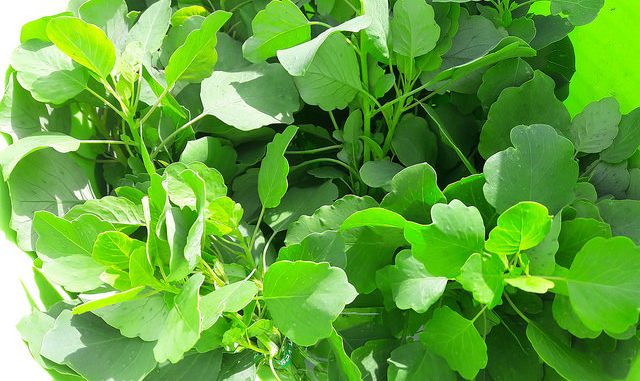
Papalo (Porophyllum ruderale) is not one of those herbs we know that well in western cuisine but it certainly has flavour qualities which could help it replace cilantro or coriander.
The herb is also known as Yerba porosa and grows in Mexico and regions of South America. The leaves flavour soups, broths and gruels. It’s most northerly growth range is New Mexico and Texas.
The flavour is similar to coriander (cilantro), rue, arugula (rocket) and mint. Whilst it is not in the same family as coriander it is also known as Bolivian Coriander. A few other names to consider: poreleaf, mampuito, papaloquelite (Mexico) and summer cilantro. In Colombia it is known as chucha, gallenaza, ruda de gallina and veadillo.
The name pápalo means butterfly in the Nahuatl dialect of Central Mexico. The leaves are like the wings of a butterfly. The Aztecs regularly used the herb not only for food but as a medicine for treating stomach complaints and reducing high blood pressure.
Culinary Uses For Papalo
Papalo has a very pungent, highly aromatic aroma and flavour. It is always eaten raw and rarely cooked. In many restaurants throughout Central America, papalo is grown or kept in vases on restaurant tables. Diners pick the leaves and shred parts of the herb into their food before eating. Drying causes the delicate, pungent aromas to disappear.
The leaves are often found in sandwiches (cemitas) and salads. Occaisonally it finds its way into guacamole. Find it served with beans, soups, and stews and grilled meats. It is related to two other herbs, Pepiche and Chepiche (Allen, 2010).
Aroma Of Papalo
Supercritical extraction with carbon dioxide was used to extract aroma compounds from dried leaves. The main aroma compounds were isosafrole, α-copaene and phytol (Conde-Hernández et al., 2017).
Oil content in the dried leaves was 0.82 to 1.35 g oil/100g dry plant material and the antioxidant activity based on Trolox units was around 5 mg equivalent per gram of oil (Conde-Hernández et al., 2017).
Growing Papalo
Seeds are sown in good compost in a frost free environment usually in September. Replant after the last frosts. It reaches up to 1.5 metres in height. Can be grown in similar style to coriander.
References
Allen, G. (2010). The Herbalist in the Kitchen. University of Illinois Press.
Conde-Hernández, L. A., Espinosa-Victoria, J. R., & Guerrero-Beltrán, J. Á. (2017). Supercritical extraction of essential oils of Piper auritum and Porophyllum ruderale. The Journal of Supercritical Fluids, 127, pp. 97-102.
I never knew about this herb until I was on holiday in Mexico and it came with an omelette. One of the most interesting herbs you can find and I think it is a great opportunity for anyone to grow and sell it in the shops. It is a real taste of Central America.
I managed to get some seeds from Mexico of this herb and I think you underplay the impact of the aroma and the flavor. It’s a bit like being hit with a heavy lime flavor – its very sharp and almost uneatable unless you use small quantities. No wonder it hasn’t had wider use but the Americans really love it.